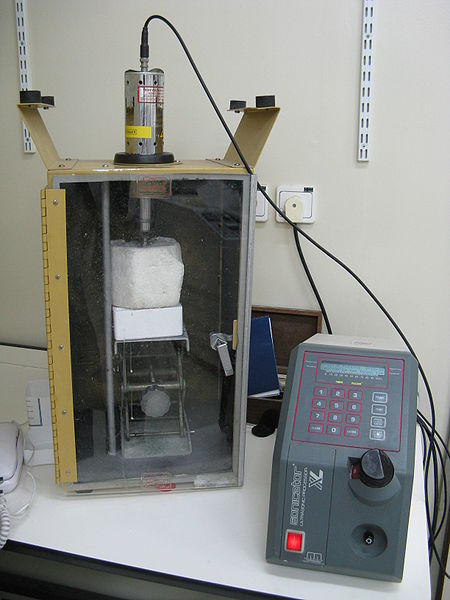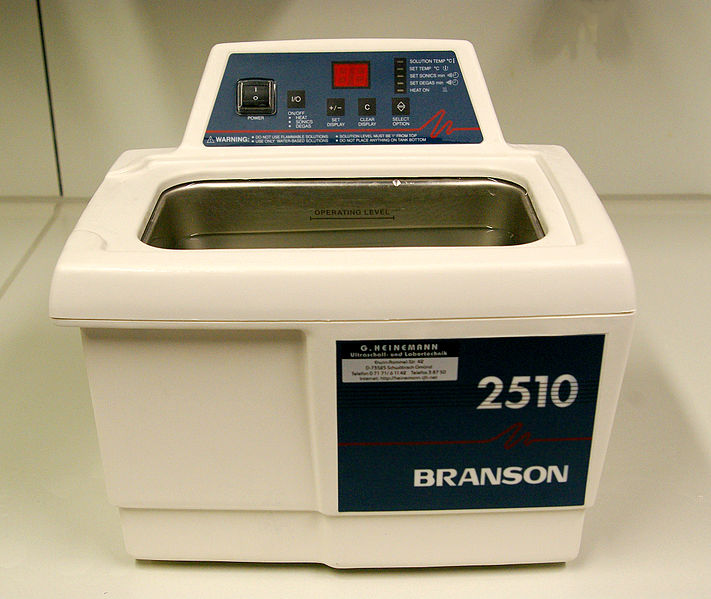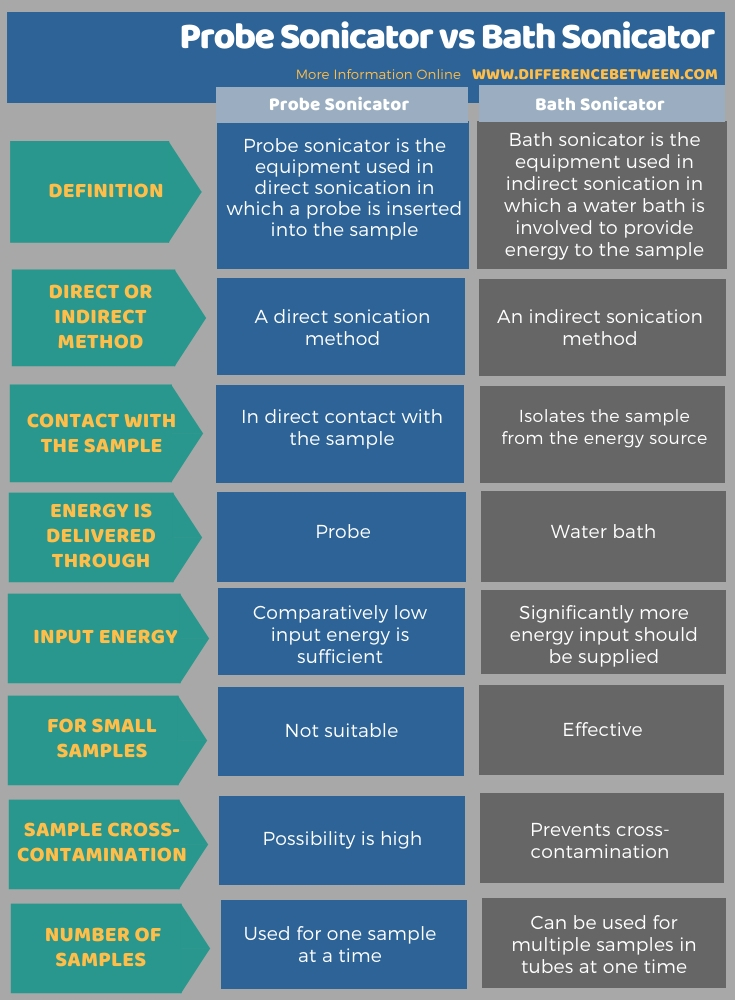The key difference between probe sonicator and bath sonicator is that in probe sonication, the probe is in direct contact with the sample, while bath sonicator isolates the sample from the energy source.
Sonication is a cell disruption method which utilizes sound energy or high-frequency sound waves to break cells. It is a physical cell disruption technique which is highly effective in disrupting bacteria, yeasts, fungi, algae and mammalian cells. When high-frequency sound waves are applied, it generates a lot of heat. Hence, it is necessary to carry out sonication under cool conditions, especially immersing the sample in an ice bath.
Sonication is best suited for samples having a volume below 100 mL. Compared to other methods, cell lysis by sonication is fast and easy to manage. Sonicator is the equipment used in sonication. Probe sonicator and bath sonicator are two types of equipment used in sonication. Probe or bath sonicator provides sound energy in the audible range.
CONTENTS
1. Overview and Key Difference
2. What is Probe Sonicator
3. What is Bath Sonicator
4. Similarities Between Probe Sonicator and Bath Sonicator
5. Side by Side Comparison – Probe Sonicator vs Bath Sonicator in Tabular Form
6. Summary
What is Probe Sonicator?
Probe sonicator is a technique by which sound energy is administered into a sample with the purpose of breaking cells. A probe is inserted into the sample, so the probe is in the direct contact with the sample. Hence, the sample receives more concentrated energy.

Figure 01: Probe Sonicator
Probe sonication is a type of direct sonication method. However, probe sonicator is not suitable for small volumes. Moreover, it can lead to sample cross-contamination and contamination by the erosion of the probe tip.
What is Bath Sonicator?
Bath sonication is an indirect sonication method in which a water bath is used. In bath sonication, ultrasonic energy is transmitted to a water bath and then into a vessel or multiple sample tubes. This method is most effective for very small samples.

Figure 02: Bath Sonicator
Bath sonicator separates samples from the energy source. Therefore, bath sonication requires significantly more energy input to energize whole water bath, unlike probe sonication. Moreover, bath sonicator eliminates the need for a probe to come into contact with the sample. Hence, the sample cross-contamination and contamination by the erosion of the probe tip can be prevented by bath sonicator. In addition to the agitation of particles in a sample or cell breaking, bath sonication is useful when cleaning objects such as spectacles and jewellery.
What are the Similarities Between Probe Sonicator and Bath Sonicator?
- Both probe sonicator and bath sonicator administer sound energy in the audible range into the sample.
- They are very useful when it is not possible to stir the sample.
- Both probe sonicator and bath sonicator are unpredictable.
- Moreover, they more often tend to overheat the samples.
What is the Difference Between Probe Sonicator and Bath Sonicator?
Probe sonicator is the equipment used in direct sonication, where a probe is inserted into the sample. On the other hand, bath sonicator is the equipment used in indirect sonication, where a water bath is used to provide energy to the sample. So, this is the key difference between probe sonicator and bath sonicator. In probe sonication, the probe is in direct contact with the sample, while bath sonicator isolates the sample from the energy source
Since the probe provides more concentrated energy to the sample, it requires comparatively low input energy while bath sonication requires significantly more energy input. Moreover, probe sonicator is not suitable for small samples, while bath sonicator is most effective for small samples.
The below infographic tabulates the difference between probe sonicator and bath sonicator.

Summary – Probe Sonicator vs Bath Sonicator
Sonication is the process of applying sound energy in order to agitate particles in a sample or breaking cells. It can be applied using an ultrasonic bath or an ultrasonic probe. Probe sonicator uses a probe to transmit ultrasonic energy to the sample. Therefore, the probe is in direct contact with the sample, and it is a direct sonication method. In contrast, bath sonicator uses a water bath to transmit ultrasonic energy. Moreover, bath sonication is most effective for small samples as well as for multiple samples in tubes. So, this summarizes the difference between probe sonicator and bath sonicator.
Reference:
1. “Sonication.” Wikipedia, Wikimedia Foundation, 7 Feb. 2020, Available here.
2. Pethe, Anil M. “Probe Sonicator.” LinkedIn SlideShare, 23 July 2018, Available here.
Image Courtesy:
1. “Sonicator” By Eyal Bairey – Own work (CC BY-SA 3.0) via Commons Wikimedia
2. “Bath sonicator device Branson 2510” By Matylda Sękpl.wiki: Cygaretkacommons: Cygaretka – Own work (CC BY-SA 3.0) via Commons Wikimedia
ncG1vNJzZmivp6x7pbXFn5yrnZ6YsqOx07CcnqZemLyue8OinZ%2Bdopq7pLGMm5ytr5Wau2680aiZnmWjpLuqr8CtpqtlkaOxbq7ArZ9mq5%2BjtqSt06ipaA%3D%3D